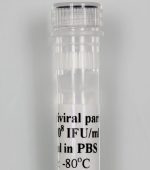Description
Lentivirus express peptide-major histocompatibility (pMH) specific T Cell Receptor (recognizing a Epstein-Barr virus) and CXCR3 receptor, containing GFP–Puromycin antibiotic selection.
The TCR construct express the antibody specifically recognizes the a Epstein-Barr virus-specific pMH (Ref 1). The TCR α chain variable region with a transmembrane (TM) domain and β chain variable region with a transmembrane (TM) domain, are linked by F2A element, as “(TRαV3/Tm)-F2A-(TRβV5-6/Tm)”
By optimizing the homing of engineered T cells to tumor sites through the expression of CXCR3, it might be possible to improve the efficacy of TCR cell therapies in the context of cancer immunotherapy.
The “target-specific TCRαV and TCRβV sequences” are derived from the verified clones according to published literatures. It also transduces a GFP–Puromycin (fluorescent-antibiotic fusion ) dual selection gene under the separate RSV promoter, which allow to enrich or select the transduced cells via GFP sorting or Puromycin killing. see the Lentivector core structure scheme below.
// –EF1a Promoter-[TCRαV(TM)-F2A-TCRβV(TM)]-P2A-CXCR3-Rsv Promoter-[GFP–Puro]– //
About pMH (peptide-major histocompatibility):
TCRs recognize short peptides bound to and presented by class I and II major histocompatibility complex (MHC) molecules on the cell surface. The binding of TCRs to their target pMHC ligands initializes the cell-mediated immune response. The discovery of TCR-pMHC pairs is a challenging task as identifying tumor-specific pMHC ligands. the identification of therapeutically relevant TCR-pMHC will lead to the activation of T cells against infectious diseases and tumors.
About CXCR3:
CXCR3 is a G protein-coupled receptor (GPCR) expressed on the surface of various immune cells, including T cells. The primary function of CXCR3 is to bind to specific chemokines, such as CXCL9, CXCL10, and CXCL11, which are often induced in response to inflammation. It plays a role in the recruitment of T cells to inflamed tissues, with enhanced antitumor immune responses.
see details in Product Manual.
Amount: 200 ul/vial at titer of 1×108 IFU/ml, concentrated lentivirus provided in PBS solution, premixed with 10x polybrene (60ug/ml), premade, ready to ship in dry-ice package.
CAT#: LVP1694

